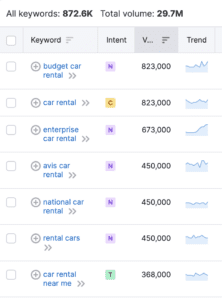What Is User Intent, and Why Is It Important?
Category: Search Engine Optimization | Tags: content marketing, infographic
Understanding user intent allows you to recognize the type of content a page should include and implement advanced keyword research. Google understands intent and uses its algorithm to bring the most relevant results possible to searchers. It’s vital to work with the search algorithm and utilize user intent in order to increase your online visibility.
What Is User Intent?
User intent is the reasoning or goal behind a user’s search. It’s necessary to rank for the right search terms that will result in a qualified lead for your business. These search terms are known as keywords.
Why is keyword research important? If you appear on a search engine result page (SERP) and your page isn’t what the user was looking for, they will leave your site. This increases your bounce rate, the percentage of site visitors that leave after viewing the page. Search engines don’t like this and will bump your ranking downwards.
Stages of Buying
If you are familiar with digital marketing, you may know that a buyer’s journey has three funnels. In the top funnel, they are curious and looking for information. In the middle funnel, they know some basics about the topic but are doing further research. Once they are at the bottom funnel, they are ready to make an informed purchase. Identifying user intent allows you to optimize web content and choose keywords that are better-suited by keeping the buying stage of your target audience in mind. For example, does your target audience know about your product or service, or are they just beginning to learn about your industry?
Keyword Intent Mapping
Once engaging in keyword research, keywords can be broken down into categories of user intention. This helps the keyword research process by making it easier to identify the target audience and purpose of a piece of content. It is a helpful way to stay organized during advanced keyword research and figure out how to increase SEO relevance.

An infographic about user intent: what is it, and why is it important?
Understanding Types of User Intent
Informational Intent
When a user has informational intent, it means they want to learn something and are seeking out knowledge. Creating content for informational intent typically involves a how-to guide, Q&A page, or similar content intended to educate the consumer.
Some examples of informational search queries would be “how often to water succulent plants” or “types of Mediterranean food.” Informational intent lives primarily in the top funnel, and also the middle. The query seeks out general or specific information.
Why is it useful? Becoming a well of knowledge and reliable source within your industry builds trust. A person who learns a lot about an industry or subject from a company is more likely to buy from them in the future. If someone is an expert in their field, they are more liable to provide high-quality products and services. It also brings more brand awareness.
Navigational Intent
Navigational intent is straightforward and to the point. Users enter a search query, typically the name of a company or location, when they are looking for a specific website or page. Some examples of this would be googling “LastPass login” to sign into your LastPass account, or searching “Facebook marketplace” rather than navigating the Facebook website to get there. This is typically the bottom funnel of the buying journey because the consumer already has their mind made up about where they want to go.
Transactional Intent
A consumer with transactional intent comes to the search engine with the intention of making a purchase. The user is often seeking out e-commerce sites with their search entry. Some examples of a transactional intent search are “waterproof sunscreen brands” or “appliance repair services.” This is a middle and bottom funnel search. The user intention is to make a purchase, and they’re making the final decision among a variety of product or service options.
When targeting keywords with transactional intent, the content can be a bit more promotional and focus on the features of a product or service.
User Intent in SEO
Improving SEO Relevance
Understanding the consumer means you can more readily offer them what they need with your content. When a user sees that your results match what they were looking for, it drives more traffic to your website and makes your page more relevant.
SEO relevance sends more potential customers to your website, and it creates a compounding interest as time goes on and more of your pages rank in search engines. Knowing user intent can ensure your content strategy goals align with what consumers are seeking and create quality content people will share.
How to Find User Intent
There are a number of tools and strategies you can use to discover user intent. There are old-school methods like conducting a consumer survey, but modern techniques can be quite advanced and require little work on your part.
A lot of search intent optimization can be done without spending a dime. Try, for example, the following:
- Explore search engines and browse the top SERP results. Contemplate the user intention that might yield each search result.
- Utilize the “People Also Ask” feature on Google to see similar questions users search on their journey.
- Answer the Public is a great free search intent tool that shows the most popular questions users asked about a certain topic. The results are even divided into question categories, like when, where, and how.
There are paid tools like Moz Keyword Explorer, Google Analytics, and Semrush, but many of them often permit users a free number of queries each month. Semrush is great for advanced keyword research and even has a user intent column for each keyword. It also allows members to filter by intent when using the position tracking tool. This means when you’re viewing the success of your SERP results, you can see which areas you are thriving in and which need improvement.

User intent optimization tool for Semrush.
Lastly, working with an SEO agency is the best way to discover user intent. At Avalanche Creative, we conduct thorough research, monitor which keywords you’re already ranking for, and determine what other keywords you should be using to target your audience for maximum results. Every piece of content we make for clients is targeted to match the user intent behind high-ranking keywords.
Optimize Content for User Intent
We can implement a content strategy that makes a difference for your company and provide tips that will revolutionize your SEO relevance. After discovering user intent based on the search queries that lead users to your page, we recalibrate our content strategy and optimize it to fit the needs of your audience. Contact us for a consultation to see how we can help you, or ask us for a free SEO strategy audit.
Ready to Invest in Empathy-Driven SEO?
At Avalanche Creative, we believe that putting yourself into the searcher’s shoes is foundational to good SEO. With the empathy to guide our decisions and the research to back them up, we have developed a tried-and-true SEO strategy. Reach out to us to learn more about how we can help your business blossom.
Share this article:
The Avalanche Email: Fun. Simple. Educational. No Selling.
Learn Result-focused SEO & Content
Join over 2,272+ others who get one email every Wednesday with simple instructions on how to get more website traffic and leads through SEO and content marketing. (Learn more about the email)
Keep Learning
How To Show Up in Gemini (And Win More Local Jobs)
Show up in Gemini when homeowners search for landscaping services. Build the right signals on Google and your website to win more qualified local jobs.
How to Run Google Ads for Landscapers: A Complete Guide
Learn how to set up Google Ads for landscapers, attract qualified leads, and win more local jobs with this step-by-step guide.
🏔️ Watering > Planting New Seeds
Your next marketing win may already be on your site. Learn how to optimize existing pages for better rankings, traffic, and results.
The Recipe vs. The Meal
Your customers buy the experience, not the product. Discover a simple way to shift your message from ingredients to the full meal.
🏔️ Hook, Line, and Sinker 🎣
Use this fishing framework to turn your posts into stories that capture attention, create tension, and inspire action from your audience.
🏔️ Avoid Everything That Doesn’t Move You Forward
Stop chasing shiny tools and refocus on what moves your marketing toward the end zone. Simple steps to cut noise and make steady progress.




